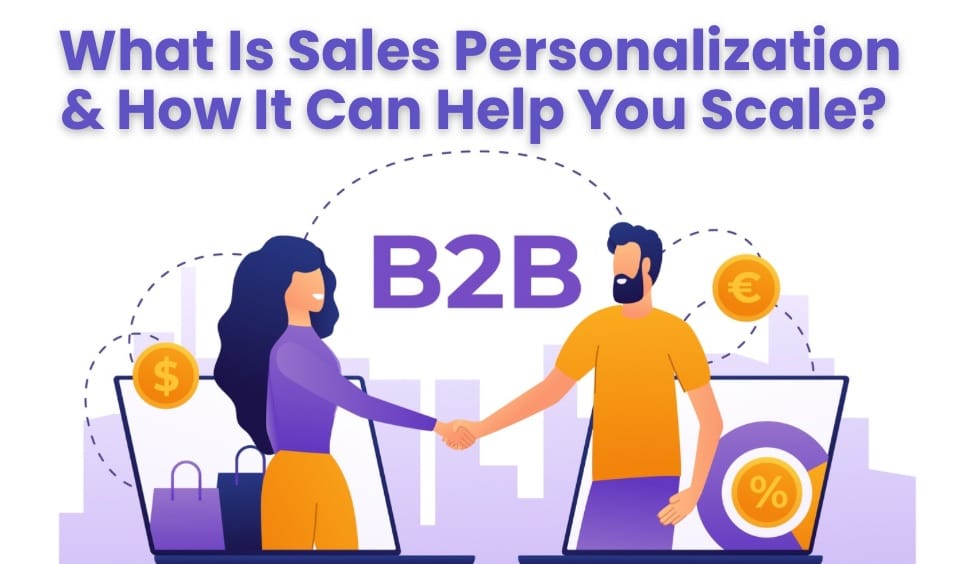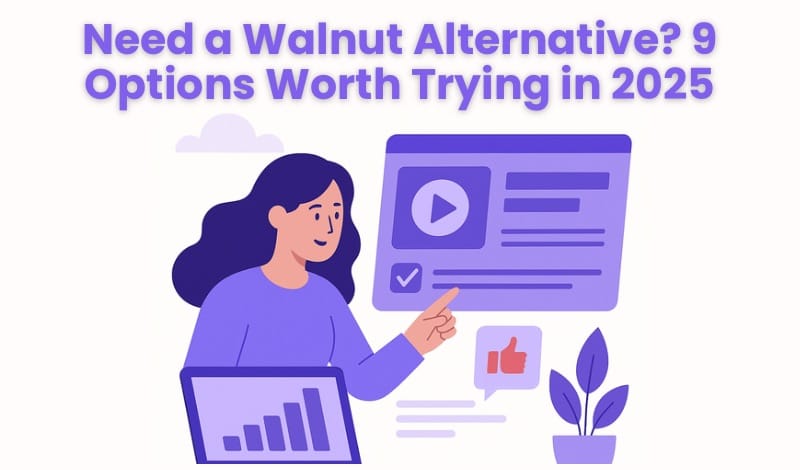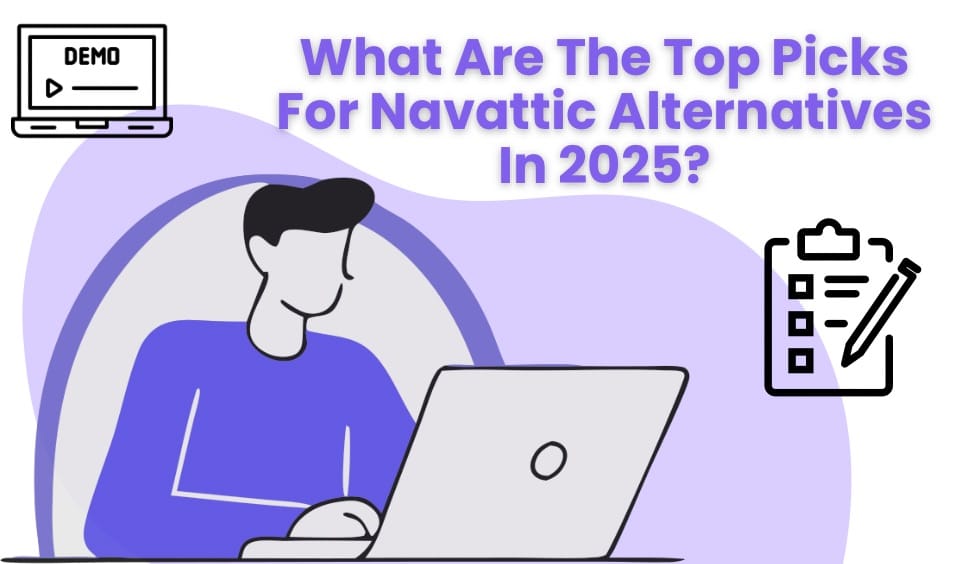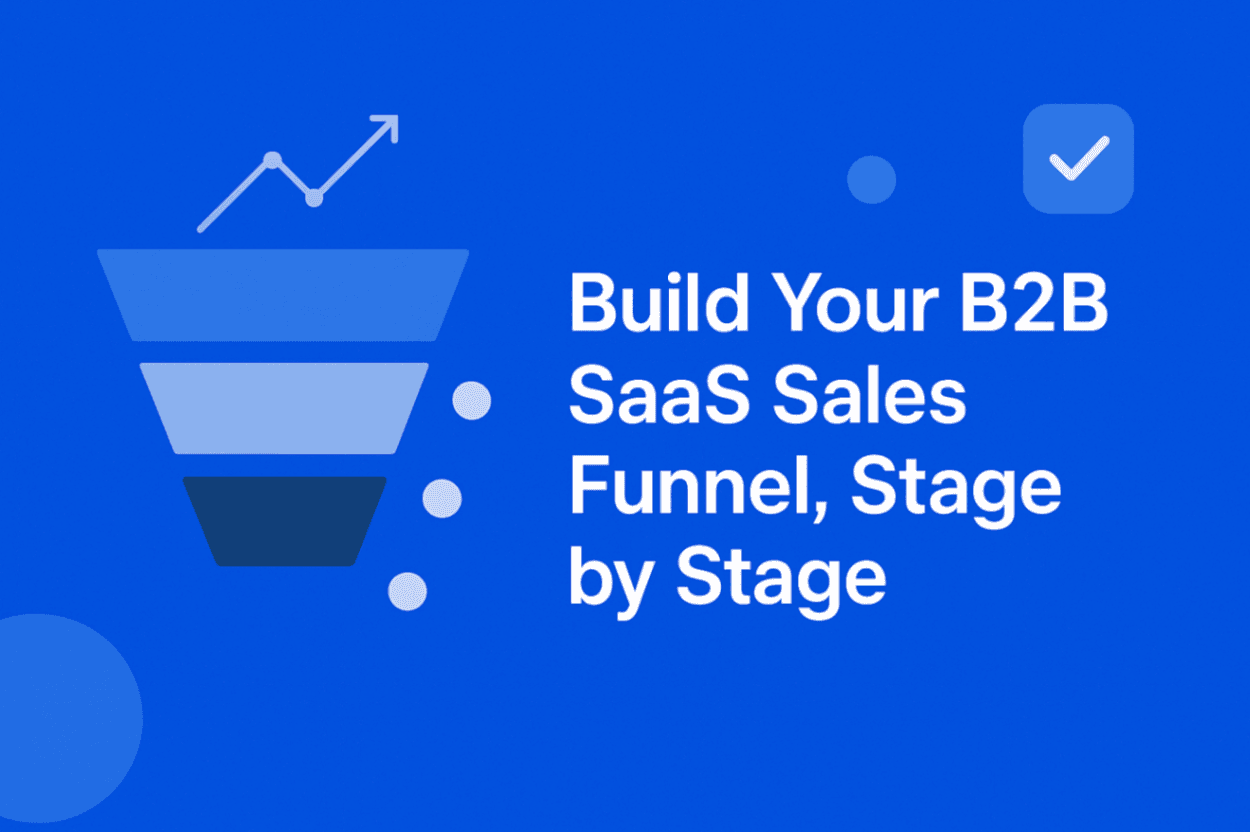
Add Table of Contents
TL;DR
|
A few years ago, we were leading growth at a SaaS startup where we thought we had everything dialed in. Traffic? Solid. Content? Crisp. Demo requests? Pouring in.
But week after week, deals stalled. Prospects ghosted after the first call. Our sales team was chasing leads that never really wanted to be sold to.
That’s when it hit us: the funnel wasn’t broken at the bottom. It was misaligned from the top.
We were pushing buyers through a journey we thought they should take: forms, follow-ups, 30-minute demos. We did this instead of meeting them where they actually were: self-educating, skipping steps, and wanting to see value fast.
We had to unlearn traditional “funnel thinking” and start building around modern SaaS buying behavior.
This blog unpacks what we learned, how to fix each stage of your B2B SaaS sales funnel, align with today’s buyers, and use platforms like SmartCue to remove friction instead of adding it.
Why Your Funnel Isn’t Converting (Yet)?
Your traffic looks healthy. The demo requests trickle in. But the close rate? Flatlined.
The issue isn’t volume. It’s velocity and precision.
Most B2B SaaS sales funnels leak in predictable places. Here's where yours might be bleeding out:
1. Are Demo No-Shows Wasting Your Team’s Time?
You book a demo. The buyer ghosts. It’s not just frustrating, it’s expensive. Every no-show wastes AE bandwidth and stretches sales cycles. In most cases, the lead wasn’t ready, they just wanted to explore the product. But your funnel made that hard.
2. Is Gated Content Costing You High-Intent Leads?
Yes, gated content turns away high-intent leads who want instant value, not forms. When you block access, they bounce to competitors who make trying the product easy. Ungate what matters and let buyers explore on their terms.
3. Are Generic Demos Killing Your Relevance?
Your buyer’s in healthcare. You’re demoing features meant for fintech. That disconnect? It kills momentum. Today’s SaaS buyer expects hyper-specific value, not a one-size-fits-all walkthrough.
4. Is Your Long Sales Cycle Losing You Deals?
If a buyer has to sit through multiple meetings just to understand your product, your funnel’s broken. The longer it takes to deliver clarity, the more deals die in limbo.
Here's the gut-punch: the average SaaS demo page converts at just 5.5% (source). That means 94 out of every 100 interested visitors vanish before even seeing your product in action.
That’s why B2B SaaS sales funnel conversion rates are a critical metric to watch, not just traffic or leads. You need visibility into how efficiently your funnel moves people from interest → intent → action.
Platforms like SmartCue help patch these funnel leaks by removing friction, embedding personalized, ungated demos directly into your buyer journey, and giving your team deep insights into where prospects drop off and why.
Spoiler: When buyers get to experience your product faster and on their own terms, they’re far more likely to convert.
How to Actually Optimize Your B2B SaaS Sales Funnel (Without Just Adding More Leads)?
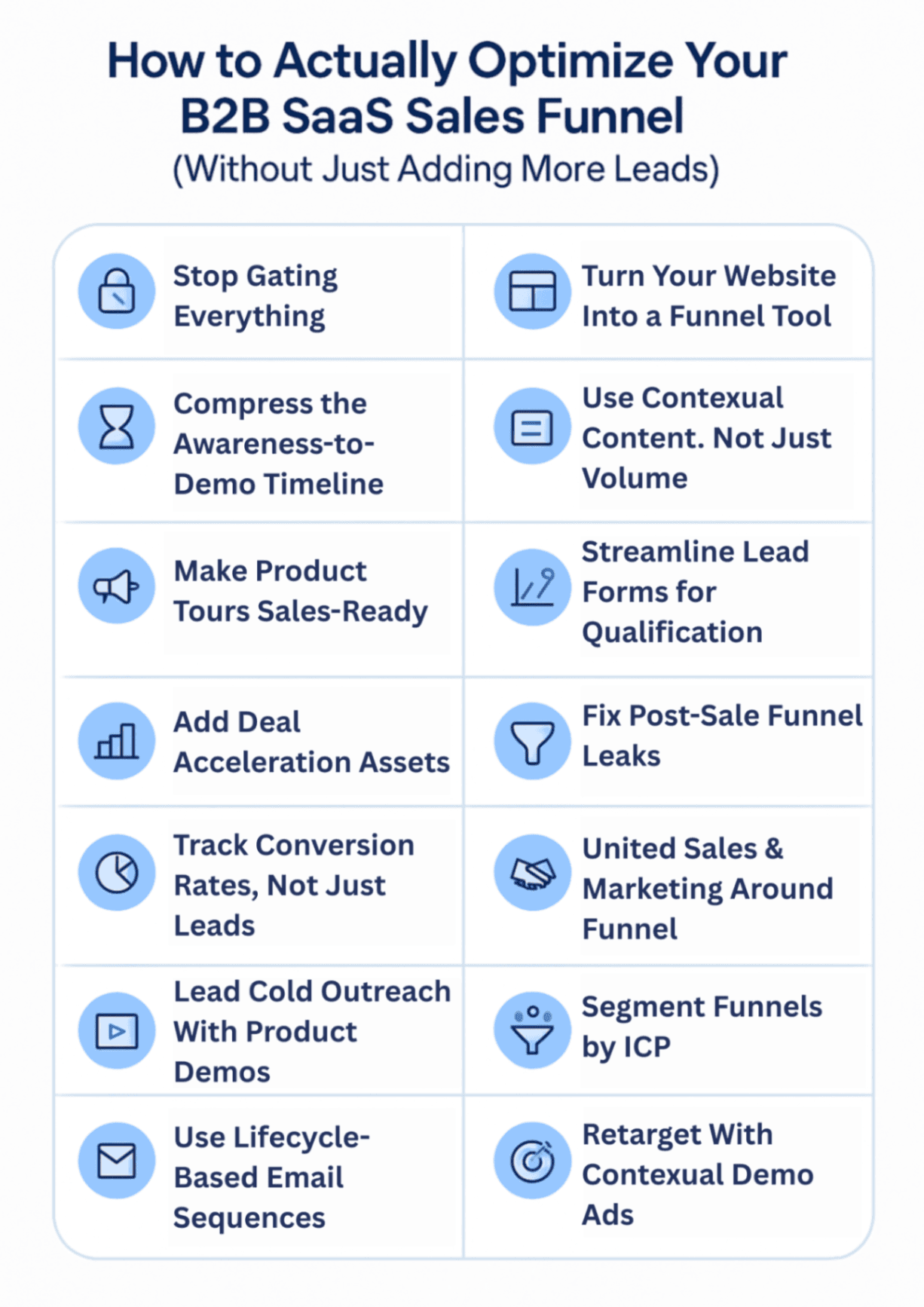
Most B2B SaaS teams don’t have a lead problem. They have a leaky funnel problem. Too many gated assets, clunky demo scheduling, and long buyer cycles that stall in the middle.
Here’s how to optimize all the development stages and make your funnel move faster, with insights that go beyond basic checklists.
1. Are You Still Gating Everything Instead of Making Product Access Frictionless?
You don’t need a lead’s life story just to let them see what your product does. Today’s buyers want a hands-on experience before they ever talk to sales.
What to do:
Embed ungated, click-through demos directly on key website pages.
Let prospects explore key workflows without filling out a form.
Keep live demos for deeper discovery, not initial exploration.
Why it matters:
This moves prospects from problem-aware to solution-aware faster, and without drop-off.
2. Is Your Website a Funnel Tool or Just a Pretty Brochure?
Most SaaS sites look great but don’t convert. Fancy design isn’t enough if your buyer can’t find what matters to them in under 30 seconds.
What to do:
Use real customer language on key pages (especially homepage, pricing, and product).
Make CTAs dynamic: “See it in action” > “Request a demo.”
Cut homepage sliders, long intros, or video that autoplays with sound (yes, still a thing).
Why it matters:
Your site is often the first and sometimes the last interaction. If it’s not funnel-optimized, it’s just window dressing.
3. How Can You Compress the Awareness-to-Demo Timeline?
Every extra click or form adds friction. And buyers who wait to see your product forget why they cared in the first place.
What to do:
Include “Try a Demo” buttons on high-intent content like comparison pages and ROI calculators.
Let SDRs drop demo links into outbound cadences, no calendar needed.
Auto-qualify leads based on demo engagement (not just form data).
Why it matters:
Shorter paths to value = fewer drop-offs and more informed conversations once buyers do get on a call.
4. Are You Creating Contextual Content or Just Churning Out Volume?
It’s tempting to publish 100 blogs and hope SEO brings the leads. But high-converting funnels don’t just attract traffic; they guide buyers.
What to do:
Build content clusters around buying stages, not just keywords (awareness → evaluation → implementation).
Map every content asset to a specific funnel goal: generate, qualify, convert, or retain.
Create competitor comparison pages, but keep it honest. Transparency builds trust.
Why it matters:
Buyers are researching with intent. If your content doesn’t meet them there, someone else’s will.
5. Is Your Product Tour Sales-Ready or Just a Feature Dump?
Let’s be honest, most product tours are feature dumps with a UI walkthrough. That’s not enough anymore.
What to do:
Segment your product tours by persona and pain point, not feature category.
Add light personalization (like industry examples or role-specific flows).
Track which parts of the demo get the most engagement and adjust content accordingly.
Why it matters:
Modern buyers want to see their world in your product. Not a generic interface.
6. Are Your Lead Forms Streamlined for Qualification?
A long form with 10 fields screams, “We care more about our CRM than your time.” But collecting zero context means wasted SDR hours.
What to do:
Ask 2-3 critical qualifying questions (industry, team size, use case).
Use progressive profiling to reveal more fields over time.
Pre-fill data with tools like Clearbit or ZoomInfo to reduce user effort.
Why it matters:
Forms should feel like a conversation, not a tax.
7. Are You Using Deal Acceleration Assets at the Bottom of the Funnel?
The decision stage often gets ignored. But this is where buyers are looking for validation: ROI, credibility, simplicity.
What to do:
Build customer testimonial pages filtered by industry or persona.
Create ROI calculators and pricing comparison sheets.
Include one-click access to demo replays for internal champions.
Why it matters:
Bottom-funnel assets close deals. Without them, you’re relying on verbal persuasion in an 8-person buying committee.
8. Are You Plugging Post-Sale Funnel Leaks, or Letting Revenue Slip?
A funnel doesn’t end at the sale. If onboarding is clunky, you’re looking at churn risk before the first renewal.
What to do:
Use guided walkthroughs to onboard new users to their first “aha.”
Tie onboarding to success milestones, not just logins or MAUs.
Proactively surface underused features with contextual prompts.
Why it matters:
Onboarding isn’t just support, it’s revenue protection.
9. Are You Tracking Funnel Health With Metrics Like Conversion Rates?
Conversion rates between funnel stages are more actionable than “total leads.” If you’re only tracking volume, you’re missing the story.
What to do:
Monitor conversion benchmarks:
Visitor → Lead: ~1–3%
Lead → MQL: ~10–15%
MQL → SQL: ~13%
Demo → Closed/Won: ~5–6%
Optimize demo engagement analytics (view time, drop-off point) as a qualifying signal.
Build a funnel dashboard that’s visible to both sales and marketing.
Why it matters:
Funnels that aren’t measured can’t be optimized.
10. Are Marketing and Sales United Around the Funnel?
Most funnel inefficiencies are alignment problems in disguise. When marketing owns top of funnel and sales owns the rest, handoffs drop the ball.
What to do:
Create shared demo libraries for both teams.
Use feedback from sales calls to refine content and CTAs.
Hold weekly funnel reviews focused on conversion not just lead volume.
Why it matters:
Funnels aren’t linear, but your GTM teams should still move in sync.
11. Why Not Make Cold Outreach Demo-First?
Why ask for 15 minutes when you can give value upfront?
Instead of the standard “got time for a quick call?” message, lead with an interactive product walkthrough customized to the recipient’s role or industry. This shifts the mindset from pitch to preview and warms up cold leads fast.
Use it when: You're running outbound campaigns via LinkedIn, email, or events.
12. Are You Segmenting Your Funnel by ICP or Sticking With One-Size-Fits-All?
A one-size-fits-all funnel will always underperform. Break it.
Map out mini-funnels for each core persona or vertical. For example, the messaging and demo flow for a Head of Ops will differ drastically from a Marketing Director, even if both are SaaS buyers.
Segment your content, CTAs, and demo experiences accordingly. It’s more work, but higher intent = higher close rates.
Use it when: You have 2–3 core personas or buying committees with different pains and paths.
13. Are Your Email Sequences Mapped to Lifecycle Stages or Just Timelines?
Nurture is not just for the middle of the funnel.
Create email sequences aligned with funnel stages, not just time delays. For example:
TOFU: Guides, explainer content, industry pain points
MOFU: Use-case demos, customer stories, ROI calculators
BOFU: Objection handling, pricing FAQs, competitive comparisons
Post-sale: Activation nudges, walkthroughs, referral asks
Use it when: You have a CRM/marketing automation tool that can be triggered by behavior or lifecycle stage.
14. Are You Retargeting With Contextual Demo Ads or Wasting Ad Spend on Generic Messaging?
If someone landed on your demo page but didn’t convert, don’t serve them a generic brand ad.
Retarget based on behavior. For example:
Viewed feature page → serve demo on that specific feature
Read comparison blog → serve ad highlighting your competitive edge
Started demo → serve an ad reminding them to finish
Use it when: You’re running paid retargeting (Meta, Google Display, or LinkedIn).
What Separates Interest from Revenue in SaaS Funnels? The Friction.
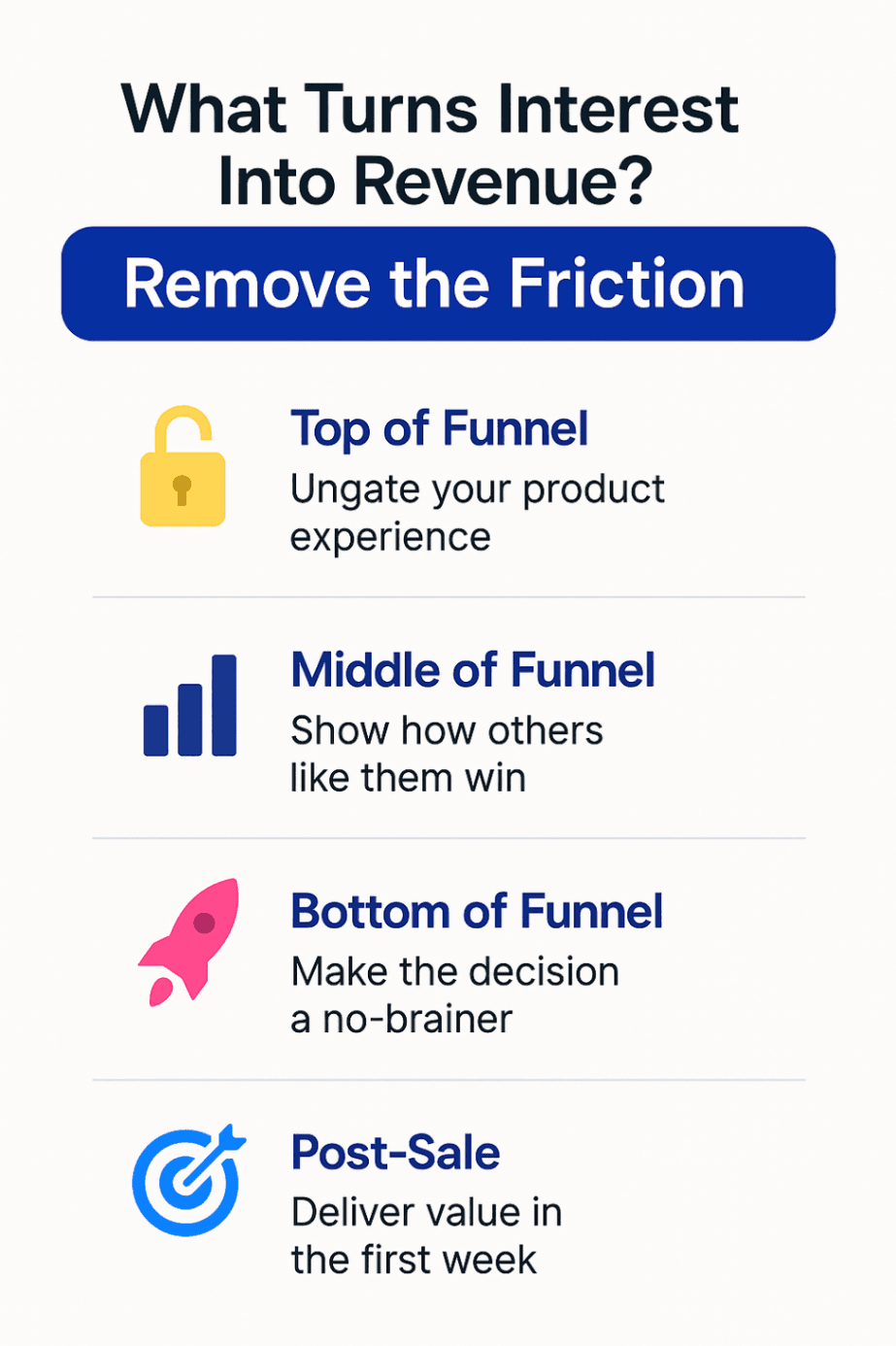
In most SaaS teams, the funnel looks clean. TOFU campaigns are firing. Demos are being booked. But somewhere between that first click and the signed deal, things stall.
Maybe it’s the fourth stakeholder loop. Maybe it’s that your champion “goes quiet.”
This section breaks down how to strip friction from every funnel stage, so your buyer doesn’t lose steam before the close. Think fewer back-and-forths, clearer handoffs, and faster paths to “yes.”
Is Your Top of Funnel (TOFU) Attracting or Actually Qualifying Buyers?
Buyers at the top don’t want to be sold to; they want to self-educate. But most SaaS websites still gate everything behind a form and call it a day.
That’s a mistake.
Practical tips:
Ungate your best assets. Yes, even your product walkthrough.
Use TOFU blog content to surface specific use cases, not generic features.
Create “choose-your-own-adventure” paths on your homepage: industry, role, or pain-point based.
Prioritize intent signals over vanity metrics. Scroll depth > bounce rate.
Most importantly, give curious prospects a way to experience your product without talking to anyone.
Is Your Middle of Funnel (MOFU) Helping Buyers Build the Internal Business Case or Leaving Them Guessing?
This is where deals get stuck in "maybe." Not because the product isn’t good, but because your buyer doesn’t know how to explain its value internally.
Practical tips:
Build micro-case studies tailored to their vertical and KPIs.
Send ROI snapshots in PDF, not 10-slide decks.
Create a value matrix that compares your offering with alternatives from your buyer’s POV.
Equip sales with modular demo assets, so they’re not building from scratch for every call.
Buyers want confidence, not more information. Show them how someone like them wins with you and make it embeddable for internal use.
Are You Making It Easy for Buyers to Say “Yes” at the Bottom of Funnel (BOFU)?
Most late-stage deals don’t die; they decay.
Your champion is sold. But now you’re competing against inertia, procurement, or another vendor who’s just a bit easier to sell internally.
Practical tips:
Send follow-up materials that are stakeholder-ready, clean, concise, and business-case forward.
Include implementation timelines with dependencies clearly mapped.
Use deal accelerators tied to actual value, not just discounts.
Create assets your champion can literally forward, like “How We’ll Roll This Out in 30 Days.”
At this point, you’re not selling the product; you’re helping them sell the decision.
Are You Setting Up Post-Sale Activation for Success or Leaving It to Chance?
Most SaaS churn isn’t due to a bad product. It’s due to a weak handoff. Onboarding gets squeezed, users go dark, and suddenly “adoption” is just a dashboard number.
Practical tips:
Prioritize first-week success metrics over long-term milestones.
Map onboarding to job roles, not just features.
Offer contextual walkthroughs embedded within your app, not hidden in help docs.
Use demo content as evergreen internal training material.
The goal: make your product indispensable in the first 30 days, not just accessible.
In this stage, SmartCue lets CS teams deliver interactive, role-based tours that walkthrough new users from sign-in to first value, without asking them to sit through another Zoom training.
How to Use SmartCue to Create Demos That Drive Higher Engagement?
Let’s build your first demo together, step by step!
Step 1: How to Sign Up & Log In?
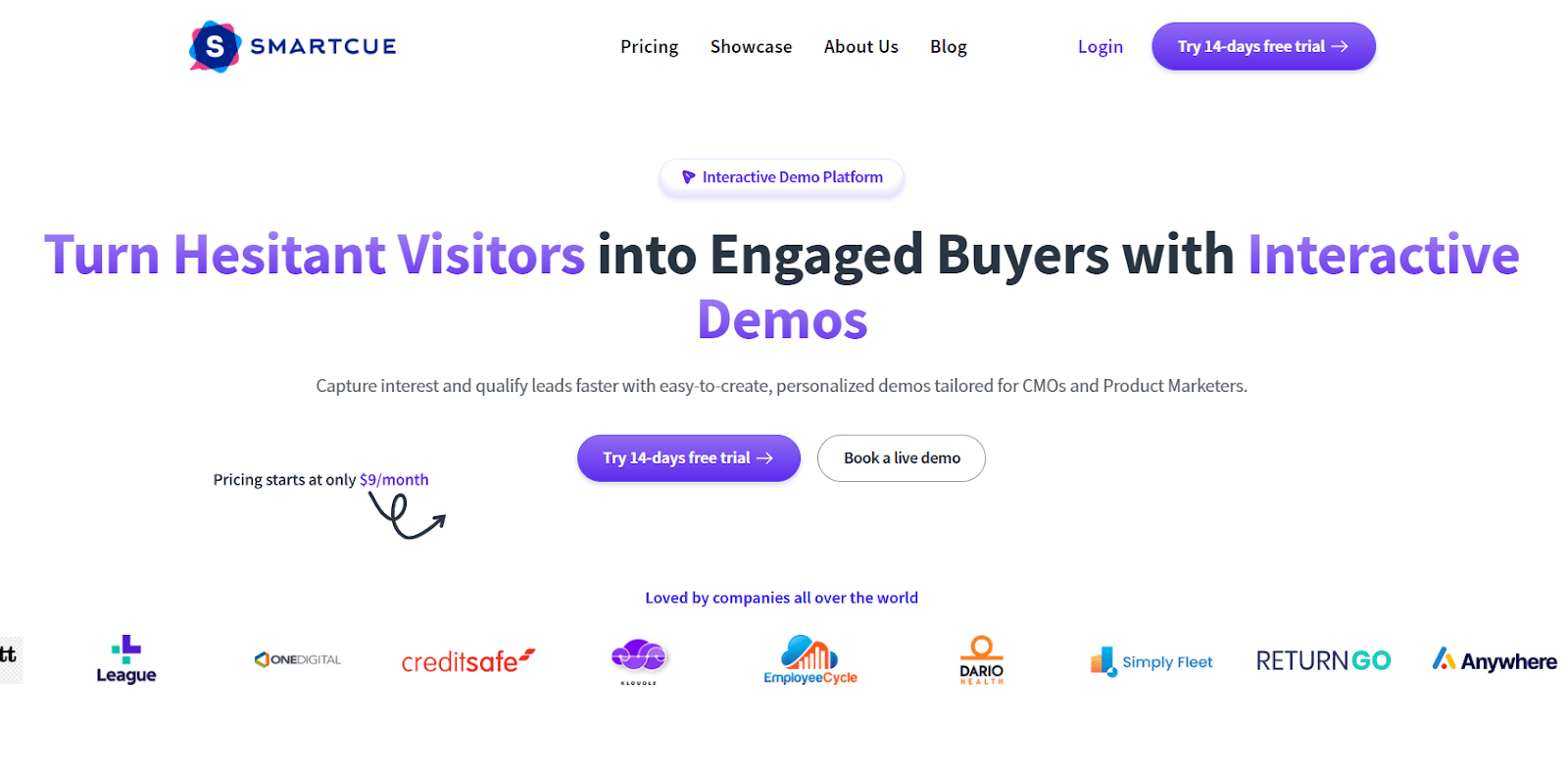
Start with a free trial and explore SmartCue’s intuitive interface.
No steep learning curve, just sign up and get started immediately.
Step 2: How to Create a New Showcase?
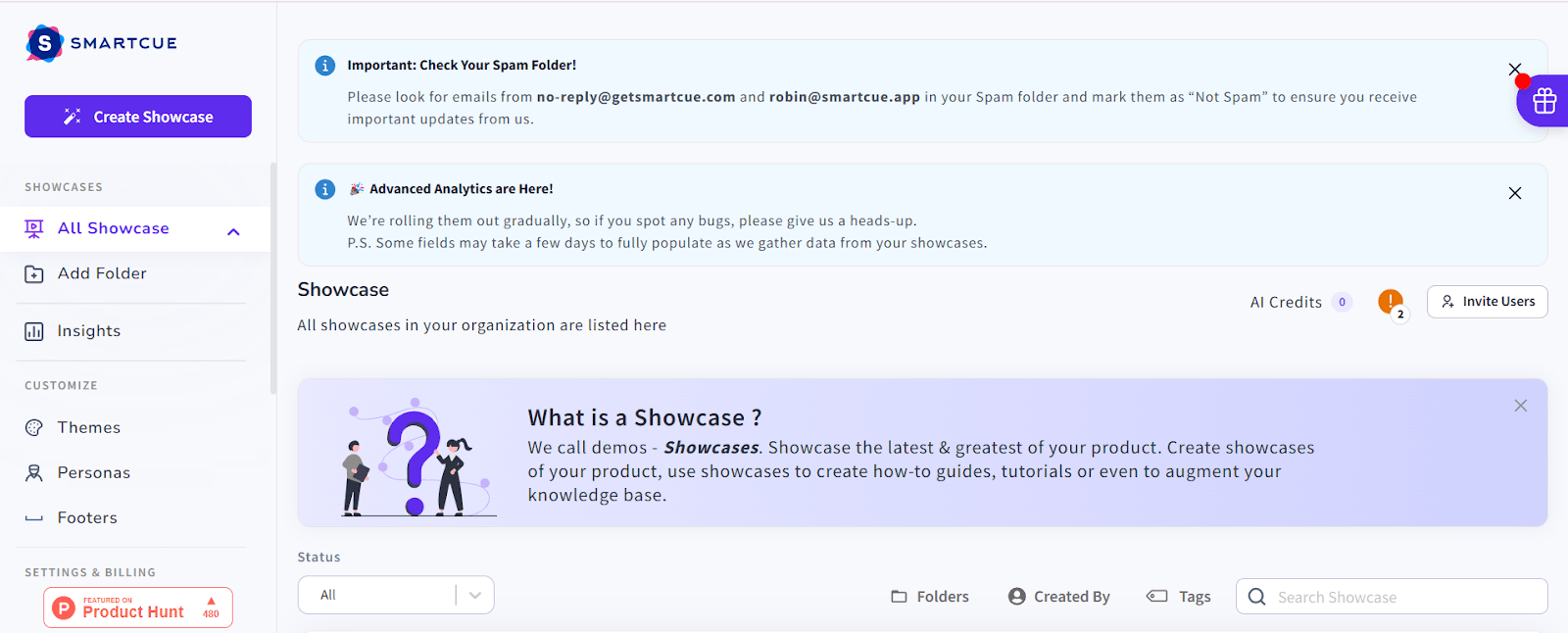
Easily create a showcase by either manually uploading content or using the SmartCue extension for faster setup.
Choose the method that best fits your workflow.
Step 3: How to Build the Showcase?
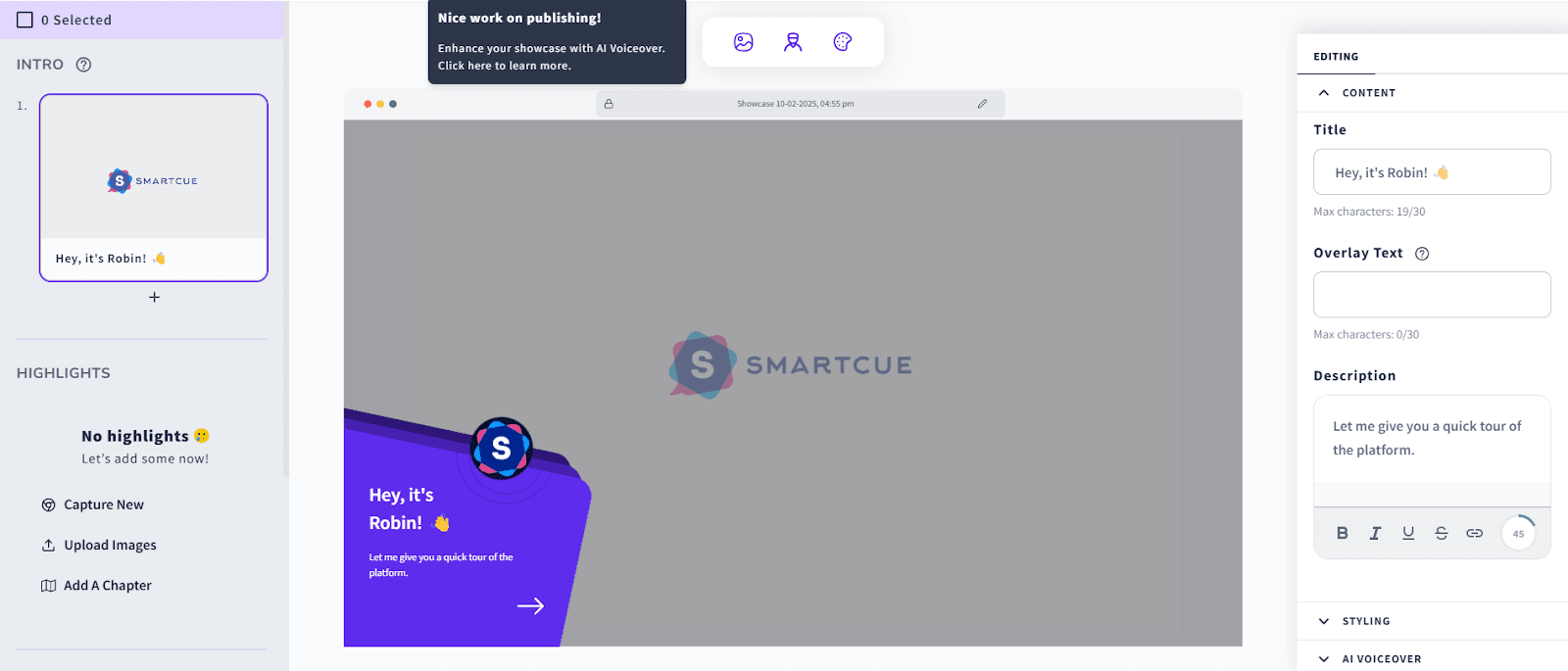
Enhance your demo by adding text descriptions, annotations, and interactive elements.
Leverage SmartCue’s integrated tools to make the demo more engaging and informative.
Step 4: How to Publish & Share?
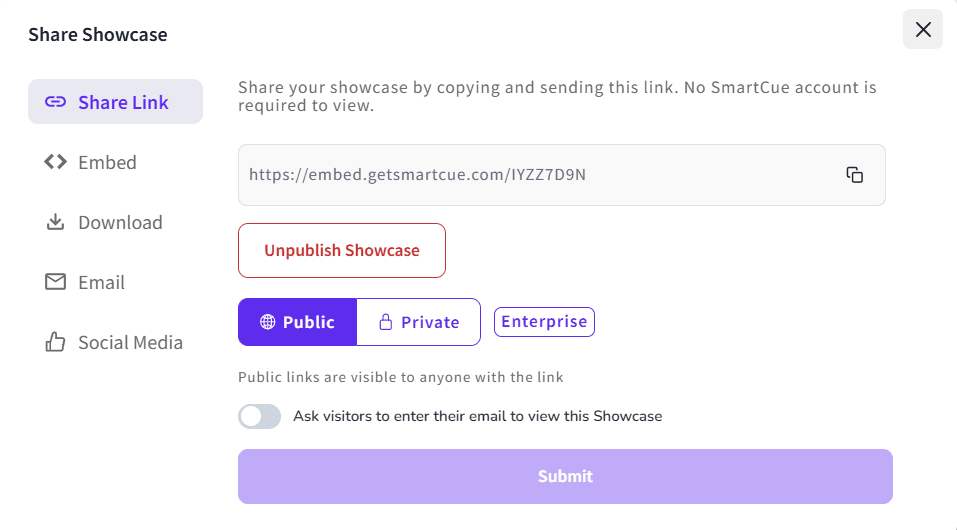
Once you're happy with your demo, tap ‘Publish’ to finalize it.
Save your progress and share the showcase with prospects and teams, or embed it in your marketing materials.
Ready to build high-converting demos? Start your free 14-day trial now!
Frequently Asked Questions
What is a B2B SaaS sales funnel?
A B2B SaaS sales funnel is the structured selling process that guides potential clients from brand awareness to conversion. It maps the customer journey across different stages, from website visits to qualified leads, using content marketing, social media, and email marketing to drive customer acquisition at a reasonable customer acquisition cost.
What are the key stages of a B2B SaaS sales funnel?
The key stages of a successful SaaS sales funnel include the awareness stage (building brand awareness via blog posts and social media), the engagement stage (delivering valuable content and lead magnets), and conversion (through product demos, landing pages, and capturing contact information). These stages support the sales pipeline and help reduce the customer churn rate.
Why do SaaS funnels often break post-demo?
This is because the next step isn’t clear. Use sales funnel metrics and a clear marketing strategy to guide potential customers through the SaaS sales funnel metrics from interest to commitment and reduce your churn rate. These b2b saas sales funnel KPIs reflect true business growth and customer retention potential.
How can I measure the success of my sales funnel b2b SaaS?
Track monthly recurring revenue, customer lifetime value, and conversion rates at each stage of the funnel. These b2b saas sales funnel KPIs reflect true business growth and customer retention potential.
What role do demos and trials play in the B2B SaaS sales funnel?
Product demos and trials play a pivotal role in the SaaS marketing funnel by improving user experience and customer satisfaction. They help potential users understand the SaaS product’s value proposition, turning potential leads into new customers and boosting average revenue over a given period of time, a best practice for any SaaS company.
